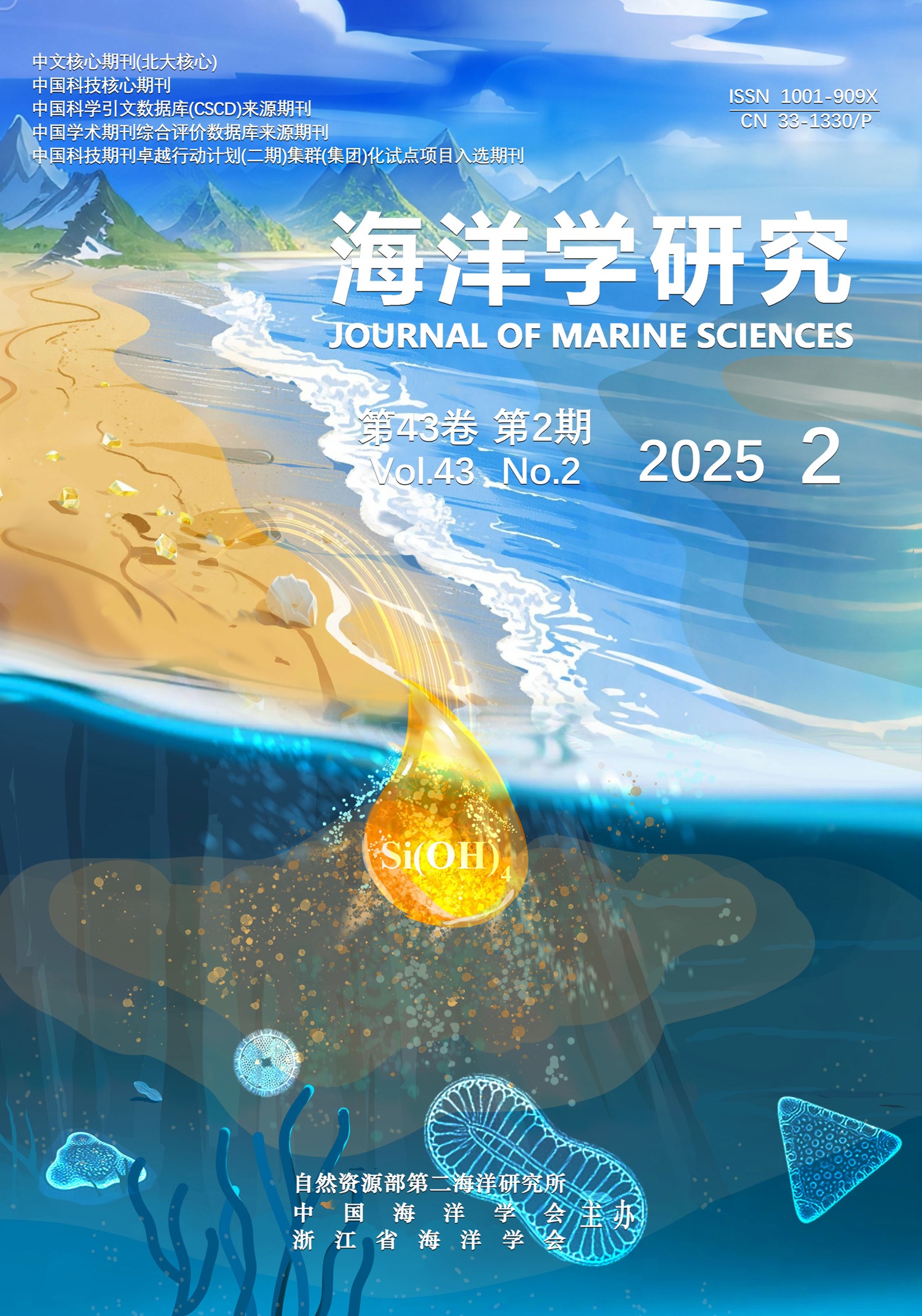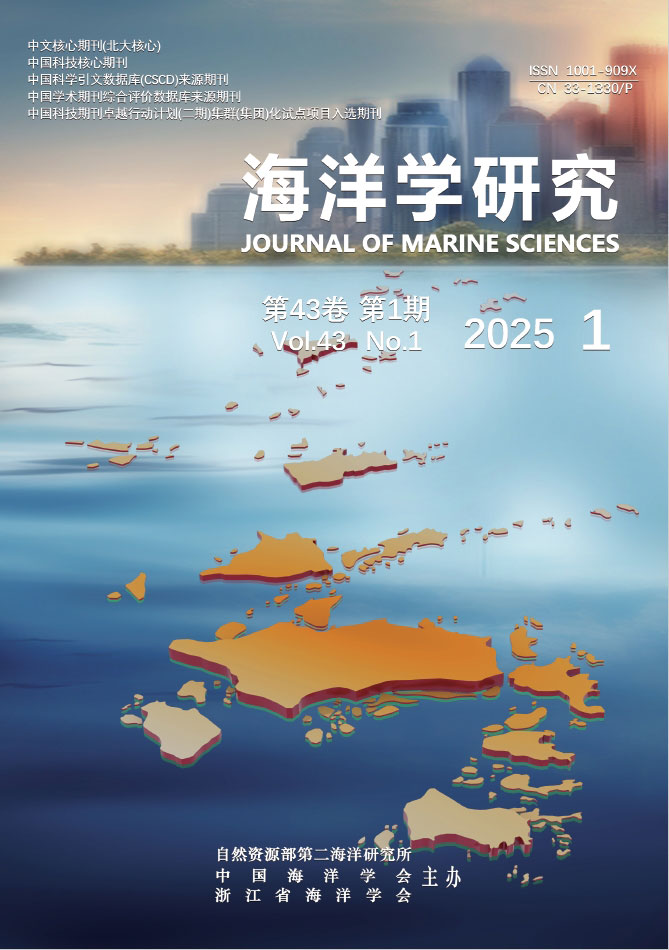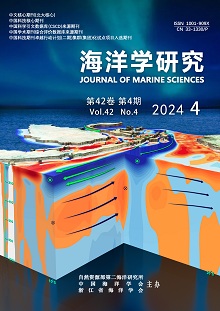-
In 1988, the tropical Pacific experienced a strong La Niña event, during which significant equatorial Pacific easterly wind surges were observed. Analysis based on reanalysis data indicates that the intensity of the 1988 surges reached the highest level during 1982-2020. Linear regression results show that the equatorial Pacific SST gradient contributed 70.59% to the surge intensity index in 1988. Further examination of wind field characteristics after removing the influence of the SST gradient reveals that, apart from the enhanced spatial extent of the surge event in late February, both the frequency and magnitude of surges decreased significantly from mid-March onward. To gain deeper insight into the specific causes of the easterly wind surges, a typical case analysis was then conducted to investigate the triggering mechanism of a representative event. Composite analysis confirms that the strong easterly wind surge at the end of March 1988 was closely linked to the convectively active phase of a Madden-Julian Oscillation (MJO) event over the Maritime Continent, which contributed approximately 42.96% to the surge’s formation.
-
To assess the potential impact of plumes generated by deep-sea mining on the midwater ocean, this study systematically analyzed the flow field characteristics of the intermediate currents at the 1 000 m and 2 000 m in deep-sea mining areas of the Pacific Ocean (Western Pacific: Block C, Block M, Block CW, Block WJ; Eastern Pacific: Block A5, Block KW, Block EK, Block A12678, Block A3, Block A4) and predicted the zonal movement trend of midwater plumes. The analysis was based on the global Argo float trajectory and mid-depth current dataset from the China Argo Real-Time Data Center covering the period from August 1997 to October 2024, combined with data from 3 moored observation stations. The results show that: (1)The currents at the 1 000 m layer in the Pacific mining areas are mainly controlled by zonal currents, with the velocity of eastward jets being greater than that of westward jets. The velocity and direction of currents in the mining areas are sensitive to changes in latitude. (2)The eastward jets that affect the 1 000 m flow field in the Western Pacific mining area have the center located at 14°N (weak) and 18°N (strong). Under their influence, in the southern part of the Block M, the midwater plumes move eastward. In other areas, the midwater plumes move slowly westward.(3) The eastward jets that affect the 1 000 m layer of the Eastern Pacific mining areas have the centers located at 7°N and 9°N. They are stronger in summer and autumn, and weaker in winter and spring. (4)The flow field directional characteristics in the 2 000 m area of Block M, Block A5, Block KW and Block EK are the same as those in the 1 000 m layer, indicating that the depth affected by jets can reach 2 000 m.
-
Optical survey and evaluation of deep-sea polymetallic nodules face challenges such as low contrast, small object detection, and boundary ambiguity. This study proposes an improved Mask R-CNN model incorporating dynamic sparse convolution (DSConv) and simple parameter-free attention module (SimAM) for nodule image segmentation. SimAM effectively suppresses sediment background interference, while DSConv alleviates boundary blurring. The combined model achieves an accuracy of 91.5%, precision of 78.0%, recall of 75.1%, and IoU of 69.4%. When applying the improved model and the original model to the actual survey lines, it was found that in the identification results of the seabed nodules coverage rate, the proportion of data with an error less than 5%, increased from 57% of the original model to 77% of the improved model. This research can provide a reliable technical solution for the calculation of deep-sea polymetallic nodule coverage rate, and its modular design can also be extended to other fields of target recognition and image segmentation.
-
Analysis of the formation mechanisms of the equatorial Pacific easterly wind surge in 1988WANG Dazhi, LIAN Tao2025, 43(3):1-10. DOI:10.3969/j.issn.1001-909X.2025.03.001
-
Evaluation the nonlinear wave spectrum of third-order Stokes waves based on NDBC buoy dataHE Chaochao, WANG Ziyun, CAI Feng, WANG Haili, WANG Jin, LIU Yuli, DONG Changming2025, 43(3):11-20. DOI:10.3969/j.issn.1001-909X.2025.03.002
-
Intermediate currents and midwater plumes in deep-sea mining areas of the Pacific Ocean based on Argo trajectory dataLIU Nuan, XU Dongfeng, YAO Zhixiong, WANG Jun, LIU Zenghong, YANG Chenghao, YANG Haiyan, BAO Hairong2025, 43(3):21-31. DOI:10.3969/j.issn.1001-909X.2025.03.003
-
Deep-sea polymetallic nodule image recognition method based on an improved Mask R-CNN modelWENG Zebang, LI Xiaohu, LI Jie, LI Zhenggang, WANG Hao, ZHU Zhimin, MENG Xingwei, LI Huaiming2025, 43(3):32-39. DOI:10.3969/j.issn.1001-909X.2025.03.004
-
Analysis of tidal flat erosion and deposition changes with sediment budget: A case study of Dafeng tidal flat on the Jiangsu coastLEI Si, ZHU Shibing, ZHANG Yiyi, LI Mingliang, WANG Yaping, GAO Chao, WU Ziyin, GAO Shu, ZHOU Jieqiong2025, 43(3):40-48. DOI:10.3969/j.issn.1001-909X.2025.03.005
-
Experiments on wave dissipation performance of a new seawall ecological armour blockLI Xiaoyan, YE Junwei, SHEN Jiafa, LUO Zhiwei, ZHENG Xin, ZHAO Haitao2025, 43(3):49-59. DOI:10.3969/j.issn.1001-909X.2025.03.006
-
Sedimentary characteristics and paleoenvironmental evolution during the Late Pleistocene of core NZD01 in southern Hangzhou BayDING Hao, ZHANG Penghui, CHEN Chao2025, 43(3):60-72. DOI:10.3969/j.issn.1001-909X.2025.03.007
-
Progress in the protection and restoration of China’s oyster reefs: The practice of oyster reef restoration in RuianWU Xiaowen, XUE Feng, CAI Jingbo2025, 43(3):73-80. DOI:10.3969/j.issn.1001-909X.2025.03.008
-
Food sources of benthic communities at the Weijia Gfuyot, Northwest PacificFEI Yichu, YANG Zhi, ZHOU Yadong, ZHANG Dongsheng2025, 43(3):81-91. DOI:10.3969/j.issn.1001-909X.2025.03.009
-
Checklist of dominant zooplankton species in the Western Pacific seamount regionSUN Rouxin, WANG Yanguo, YANG Yanyan, CHEN Yanghang, XIANG Peng, WANG Chunguang, XING Bingpeng2025, 43(3):92-102. DOI:10.3969/j.issn.1001-909X.2025.03.010
-
Influence of soil heavy metal distribution on carbon components in the coastal wetlands of Yueqing Bay in southern Zhejiang ProvinceWU Xue, ZHAO Xin, SUN Hongcheng, GU Weifang, ZHU Kehua, GE Zhenming2025, 43(3):110-122. DOI:10.3969/j.issn.1001-909X.2025.03.011
| 2025,Vol.43 | No.2 | No.1 | ||
| 2024,Vol.42 | No.4 | No.3 | No.2 | No.1 |
| 2023,Vol.41 | No.4 | No.3 | No.2 | No.1 |
| 2022,Vol.40 | No.4 | No.3 | No.2 | No.1 |
| 2021,Vol.39 | No.4 | No.3 | No.2 | No.1 |
| 2020,Vol.38 | No.4 | No.3 | No.2 | No.1 |
| 2019,Vol.37 | No.4 | No.3 | No.2 | No.1 |
| 2018,Vol.36 | No.4 | No.3 | No.2 | No.1 |
| 2017,Vol.35 | No.4 | No.3 | No.2 | No.1 |
| 2016,Vol.34 | No.4 | No.3 | No.2 | No.1 |
| 2015,Vol.33 | No.4 | No.3 | No.2 | No.1 |
| 2014,Vol.32 | No.4 | No.3 | No.2 | No.1 |
| 2013,Vol.31 | No.4 | No.3 | No.2 | No.1 |
| 2012,Vol.30 | No.4 | No.3 | No.2 |
-
HE Maoyu, WANG Jing, LI Sihan, LIANG LewenJournal of Marine Sciences. 2025 Vol. 43 (1): 22-33 DOI: 10.3969/j.issn.1001-909X.2025.01.003
-
YANG Bo, ZHANG Zhuo, ZHOU Jin, LIN Ziyi, XIE Ziqiang, ZHENG Huina, LIAO Baolin, XIAO BaohuaJournal of Marine Sciences. 2025 Vol. 43 (1): 90-106 DOI: 10.3969/j.issn.1001-909X.2025.01.009
-
HE Xinyi, LIU Qian, LI Xiaohu, LI Zhenggang, WANG Hao, ZHU Zhimin, LI HuaimingJournal of Marine Sciences. 2025 Vol. 43 (1): 34-46 DOI: 10.3969/j.issn.1001-909X.2025.01.004
-
HUANG Shuyi, XIE Xiaohui, LI ShaofengJournal of Marine Sciences. 2025 Vol. 43 (1): 1-13 DOI: 10.3969/j.issn.1001-909X.2025.01.001
-
ZHANG Xuan, LIU Zenghong, CHEN Zhaohui, REN Chong, XIONG Haixia, GAO Zhiyuan, YAN Xiaoluan, ZHANG LinlinJournal of Marine Sciences. 2025 Vol. 43 (1): 14-21 DOI: 10.3969/j.issn.1001-909X.2025.01.002
-
JIN Jie, CHEN Yujie, YAO Yongheng, ZHANG Siyuan, HU Zhentao, DING Mengrong, JIA BinJournal of Marine Sciences. 2025 Vol. 43 (1): 69-78 DOI: 10.3969/j.issn.1001-909X.2025.01.007
-
WANG Yang, QUAN Xin, ZHUANG Ya, ZHAO Huade, SU JianzhongJournal of Marine Sciences. 2025 Vol. 43 (1): 79-89 DOI: 10.3969/j.issn.1001-909X.2025.01.008
-
HAN Yajing, ZHENG Liwen, LI Chenglong, ZHANG Yong, ZHAI WeidongJournal of Marine Sciences. 2025 Vol. 43 (2): 1-10 DOI: 10.3969/j.issn.1001-909X.2025.02.001
-
HOU Zonghao, ZHANG Yifei, FANG Xin, DUAN YixinJournal of Marine Sciences. 2025 Vol. 43 (1): 57-68 DOI: 10.3969/j.issn.1001-909X.2025.01.006
-
WANG Xiuping, YANG Pengcheng, LIU FangyuanJournal of Marine Sciences. 2025 Vol. 43 (1): 47-56 DOI: 10.3969/j.issn.1001-909X.2025.01.005
-
CHANG Lexin, ZHU Bozhong, GUO Mao, LI Teng, GONG Fang, ZHU Qiankun, BAI YanJournal of Marine Sciences. 2025 Vol. 43 (2): 47-57 DOI: 10.3969/j.issn.1001-909X.2025.02.006
-
LÜ Congcong, YU Yang, LI Bin, SHUI Bonian, HU ChengyeJournal of Marine Sciences. 2025 Vol. 43 (2): 88-96 DOI: 10.3969/j.issn.1001-909X.2025.02.010
-
HUAN Caiyun, JIANG Zhenqiang, XU Kundi, WANG JiaxinJournal of Marine Sciences. 2025 Vol. 43 (2): 19-29 DOI: 10.3969/j.issn.1001-909X.2025.02.003
-
ZHU Lunjia, QU Ke, WANG Xu, WANG Chao, LI TiankuoJournal of Marine Sciences. 2025 Vol. 43 (1): 107-121 DOI: 10.3969/j.issn.1001-909X.2025.01.010
-
LI Guoxiang, LUO Xiaowen, WAN Hongyang, CUI Jiaxin, WEI WeiJournal of Marine Sciences. 2025 Vol. 43 (2): 58-66 DOI: 10.3969/j.issn.1001-909X.2025.02.007
-
WANG Dazhi, LIAN TaoJournal of Marine Sciences. 2025 Vol. 43 (3): 1-10 DOI: 10.3969/j.issn.1001-909X.2025.03.001
-
WANG Wenbo, XIE XiaohuiJournal of Marine Sciences. 2025 Vol. 43 (2): 11-18 DOI: 10.3969/j.issn.1001-909X.2025.02.002
-
Optimization of FVCOM model algorithm for response coefficient method: A case study of Xiangshan BayQIN Zhihao, HU Song, CHEN QinsiJournal of Marine Sciences. 2025 Vol. 43 (2): 67-78 DOI: 10.3969/j.issn.1001-909X.2025.02.008
-
ZHANG Zhaoyuan, ZHANG Huaguo, CAO Wenting, LI DonglingJournal of Marine Sciences. 2025 Vol. 43 (2): 30-38 DOI: 10.3969/j.issn.1001-909X.2025.02.004
-
LIU Liping, CHU Fengyou, GUO Lei, LI XiaohuJournal of Marine Sciences. 2023 Vol. 41 (1): 26-44 DOI: 10.3969-j.issn.1001-909X.2023.01.003
-
CAO Wenting, ZHANG Huaguo, LI RuiJournal of Marine Sciences. 2021 Vol. 39 (4): 123-131 DOI: 10.3969/j.issn.1001-909X.2021.04.012
-
Assessment of carbon sink potential and driving factors of island forests on national nature reserveWU Liangxu, ZOU Huimin, CHEN Wei, XU Minghai, CAI Houcai, CHEN Shuyi, LI XianglanJournal of Marine Sciences. 2023 Vol. 41 (1): 96-109 DOI: 10.3969-j.issn.1001-909X.2023.01.008
-
SONG Wanjiao, ZHANG Peng, SUN Ling, TANG Shihao, ZHOU Fangcheng,Journal of Marine Sciences. 2022 Vol. 40 (2): 10-18 DOI: 10.3969-j.issn.1001-909X.2022.02.002
-
DONG Changming, WANG Ziyun, XIE Huarong, XU Guangjun, HAN Guoqing, ZHOU Shuyi, XIE Wenhong, SHEN Xiangyu, HAN LeiJournal of Marine Sciences. 2024 Vol. 42 (3): 2-27 DOI: 10.3969/j.issn.1001-909X.2024.03.001
-
CUI Minghui, TU Junbiao, MENG Lingpeng, GUO Xingjie, SU Ni, FAN DaiduJournal of Marine Sciences. 2023 Vol. 41 (2): 28-44 DOI: 10.3969/j.issn.1001-909X.2023.02.003
-
LIN Junchuan, KONG Deming, CHEN Fajin, HUANG Chao,Journal of Marine Sciences. 2022 Vol. 40 (3): 49-61 DOI: 10.3969-j.issn.1001-909X.2022.03.005
-
LI YanJournal of Marine Sciences. 2022 Vol. 40 (3): 9-16 DOI: 10.3969-j.issn.1001-909X.2022.03.002
-
GE Yuyu, LIAO GuanghongJournal of Marine Sciences. 2023 Vol. 41 (2): 45-60 DOI: 10.3969/j.issn.1001-909X.2023.02.004
-
ZENG Dingyong, XUAN Jiliang, HUANG Daji, et alJournal of Marine Sciences. 2022 Vol. 40 (1): 12-20 DOI: 10.3969/j.issn.1001-909X.2022.01.002
-
CHEN Yining, CHEN LuzhenJournal of Marine Sciences. 2023 Vol. 41 (1): 3-13 DOI: 10.3969-j.issn.1001-909X.2023.01.001
-
Journal of Marine Sciences. 2022 Vol. 40 (3): 17-32 DOI: 10.3969-j.issn.1001-909X.2022.03.003
-
XU Xucheng, YU Xing, HU Hang, HE Hu, YU Ya’naJournal of Marine Sciences. 2024 Vol. 42 (2): 104-112 DOI: 10.3969/j.issn.1001-909X.2024.02.010
-
Journal of Marine Sciences. 2022 Vol. 40 (3): 99-108 DOI: 10.3969-j.issn.1001-909X.2022.03.009
-
CHEN Jianfang, ZHAI Weidong, WANG Bin, LI Dewang, XIONG Tianqi, JIN Haiyan, LI Hongliang, LIU Qinyu, MIAO Yanyi,Journal of Marine Sciences. 2021 Vol. 39 (4): 11-21 DOI: 10.3969/j.issn.1001-909X.2021.04.002
-
MA Haibo, LAI Xianghua, HU Taojun, FU XiaomingJournal of Marine Sciences. 2024 Vol. 42 (1): 83-90 DOI: 10.3969/j.issn.1001-909X.2024.01.008
-
JIN Quan, ZHANG Chuqing, WU Jianbo, ZHANG Xiao, YE Ying, HUANG Yuanfeng, TAO ChunhuiJournal of Marine Sciences. 2021 Vol. 39 (2): 52-59 DOI: 10.3969/j.issn.1001-909X.2021.02.006
-
LI Zhichao, GUO Junru, SONG Jun, BAI Zhipeng, FU Yanzhao, CAI Yu, WANG XifengJournal of Marine Sciences. 2022 Vol. 40 (4): 1-10 DOI: 10.3969j.issn.1001-909X.2022.04.001
-
LI Run-xiang, GAO-Shu, WANG Dan-dan , ZHAO Yang-yang , ZHU-Dong, XU-Zhen, ZUO-PingJournal of Marine Sciences. 2014 Vol. 32 (3): 26-35 DOI: 10.3969/j.issn.1001-909X.2014.03.004
-
ZHENG Mengke, FANG Wei, ZHANG XiaozhiJournal of Marine Sciences. 2024 Vol. 42 (3): 51-63 DOI: 10.3969/j.issn.1001-909X.2024.03.004






